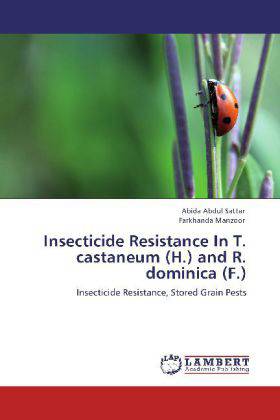
- Afhalen na 1 uur in een winkel met voorraad
- Gratis thuislevering in België vanaf € 30
- Ruim aanbod met 7 miljoen producten
- Afhalen na 1 uur in een winkel met voorraad
- Gratis thuislevering in België vanaf € 30
- Ruim aanbod met 7 miljoen producten
Zoeken
Insecticide Resistance In T. castaneum (H.) and R. dominica (F.)
Insecticide Resistance, Stored Grain Pests
Abida Abdul Sattar, Farkhanda Manzoor
Paperback | Engels
€ 77,45
+ 154 punten
Omschrijving
Synthetic insecticides have been the major control method of insect pests since 1950s. The widespread and unwise use of insecticides has resulted in the development of insect strains that are resistant to insecticides. The level of insecticide resistance was evaluated in two economically important stored grain pests, Tribolium castaneum (Herbst) and Rhyzopertha dominica (Fabricius) in the present study. Resistance level was checked against one organophosphate and four pyrethroid insecticides by using filter paper method and residual film method. Mortality was recorded after 48 hours of treatment. Resistant insects were identified on the basis of their LC50 values. T. castaneum (H.) appeared to be more resistant as compared to R. dominica (F.). Results indicated that deltamethrin 2.5% SC was more toxic of all test insecticides while DDVP 50% EC was least toxic.
Specificaties
Betrokkenen
- Auteur(s):
- Uitgeverij:
Inhoud
- Aantal bladzijden:
- 124
- Taal:
- Engels
Eigenschappen
- Productcode (EAN):
- 9783848487660
- Verschijningsdatum:
- 22/04/2012
- Uitvoering:
- Paperback
- Afmetingen:
- 152 mm x 220 mm
- Gewicht:
- 191 g

Alleen bij Standaard Boekhandel
+ 154 punten op je klantenkaart van Standaard Boekhandel
Beoordelingen
We publiceren alleen reviews die voldoen aan de voorwaarden voor reviews. Bekijk onze voorwaarden voor reviews.








